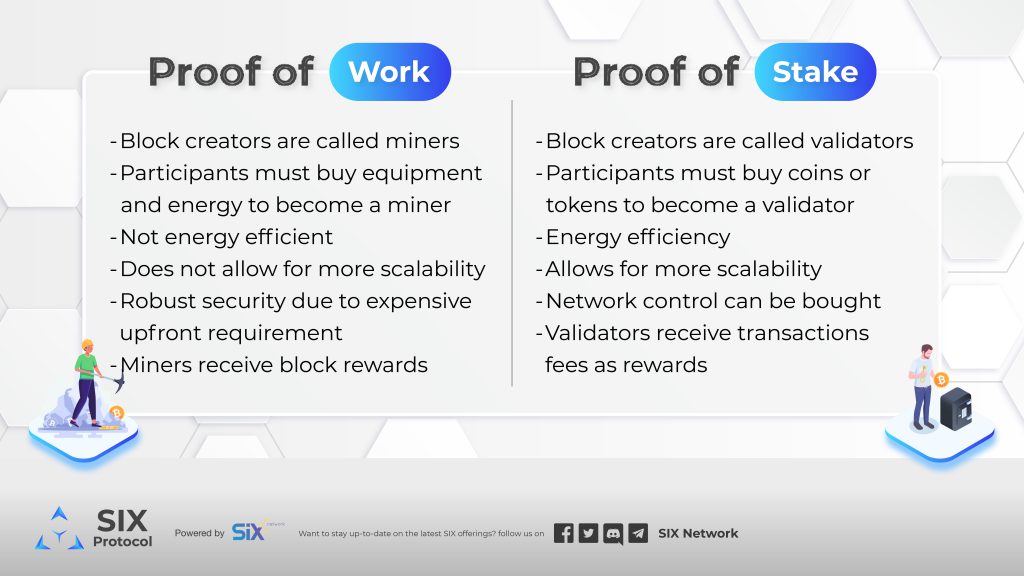
SIX Network and FANDOM STUDIO Announce Partnership Collaboration to Advance Entertainment Industry
SIX Network is excited to announce our partnership with FANDOM STUDIO for the Fan-Fi project, making it easier for fans
The verifiers of blockchain transactions are generally scoped down to two main groups of the consensus algorithm. This “verifiers” position are commonly known as validator and miner, they have the same legitimacy to help blockchains validate information, synchronize data, and process transactions. Though, both have similar task to accomplish but it’s the procedure that make the difference.
The validators are amended to Proof-of-Stake (PoS) which validators are the ones building the block of the chain enabling tasks for checking transactions, verifying activity, voting on outcomes, and maintaining records.
To become a validator is to “buy into” the position means that token owners will have to offer their tokens as collateral for the chance to validate blocks. Token owners who staked their coins will become validators and receive transaction fees as rewards.
Miners are found in Proof-of-Work (PoW) blockchain network, their task is to solve complex mathematical equations to complete the requirement of becoming nodes for a chain.
Miners usually need to invest in highly advanced equipment, powerful computer RIG, and energy power to run the work. As the name suggests, as proof of work, miners rely on the amount of work they input to receive block rewards.

Proof-of-work and mining need to solve a mathematical puzzle known as the proof-of-work problem to create a new group of trustless transactions or blocks on a distributed ledger called the blockchain.
Transactions are bundled into a block, miners jump in to verify the block legitimacy then rewards will be given to the first miner who solves each block problem; this process is called inverse hashing.
Proof of stake and validators is the consensus mechanism introduced by Peercoin and then secondly by the Ethereum chain. It is virtually portrayed by locking up the ecosystem token in the chain which is known as staking.
The overall purpose stays the same on both blocks proving the only difference is in the procedure that the validators to creating the next block are based on how much they have staked and then rewarded with proportion to the staking amount.
In conclusion PoW or PoS is crucial to a blockchain ecosystem to help in the validation of blocks and synchronizing data to create a whole new chain, stabilizing the security within the network through the work performed by miners and validators.
In recent days many blockchain networks are turning to Proof-of-Stake as their consensus process which allows validators to stake tokens in the system and strengthen the security of the blockchain.
SIX Protocol will soon launch and is thrilled to invite everyone to become our validators of the network the procedure is based on Proof-of-Stake Authority (PoSA).
The Individual Node Validator is specified for people who are looking for the opportunity to become a part of consensus verifiers of a network. We are looking forward to you staying tuned for the big announcement and learning more about how to join Individual Node Validator by following this link.

SIX Network is excited to announce our partnership with FANDOM STUDIO for the Fan-Fi project, making it easier for fans

SIX Network มีความยินดีอย่างยิ่งที่จะประกาศร่วมเป็นพาร์ทเนอร์กับ FANDOM STUDIO เพื่อพัฒนาอุตสาหกรรมสื่อและวงการบันเทิงให้เติบโตยิ่งขึ้น ผ่านนวัตกรรมบล็อกเชนจาก SIX Ecosystem การร่วมมือกันครั้งนี้เป็นการส่งเสริมธุรกิจหรือวงการบันเทิง หรือ สร้างกิจกรรมที่ทำให้แฟนคลับกับผู้ใช้งานสามารถเข้าถึงศิลปิน, ไอดอล, ผลงานเพลง และสิทธิประโยชน์อื่น ๆ จาก Fan-Token NFT ซึ่งเป็นเหรียญประจำแพลตฟอร์มที่ใช้งานเพื่อรับสิทธิพิเศษต่าง

SIX Token จะถูกลิสต์บน Bitget แพลตฟอร์มแลกเปลี่ยนคริปโตชั้นนำ ในวันที่ 29 เมษายน 2567 SIX Network บริษัทผู้ให้บริการด้าน Blockchain Solutions ได้ประกาศการลิสต์ SIX token ($SIX) ใน

SIX Token is Listing on Bitget Best Copy Trading Platform on April 29, 2024 SIX Network, a prominent player

Let’s get to know Ethereum’s Next Big Thing “EigenLayer” Protocol Hottest Ecosystems. Currently! You can’t miss EigenLayer these days –

SIX Network made strategic advancements in the first quarter of 2024, announcing our Roadmap 2024. Key milestones were established, with

Fulltime learner | Passionate Writer | Investment Geek
| Cookie | Duration | Description |
|---|---|---|
| cookielawinfo-checkbox-analytics | 11 months | This cookie is set by GDPR Cookie Consent plugin. The cookie is used to store the user consent for the cookies in the category "Analytics". |
| cookielawinfo-checkbox-functional | 11 months | The cookie is set by GDPR cookie consent to record the user consent for the cookies in the category "Functional". |
| cookielawinfo-checkbox-necessary | 11 months | This cookie is set by GDPR Cookie Consent plugin. The cookies is used to store the user consent for the cookies in the category "Necessary". |
| cookielawinfo-checkbox-others | 11 months | This cookie is set by GDPR Cookie Consent plugin. The cookie is used to store the user consent for the cookies in the category "Other. |
| cookielawinfo-checkbox-performance | 11 months | This cookie is set by GDPR Cookie Consent plugin. The cookie is used to store the user consent for the cookies in the category "Performance". |
| viewed_cookie_policy | 11 months | The cookie is set by the GDPR Cookie Consent plugin and is used to store whether or not user has consented to the use of cookies. It does not store any personal data. |
